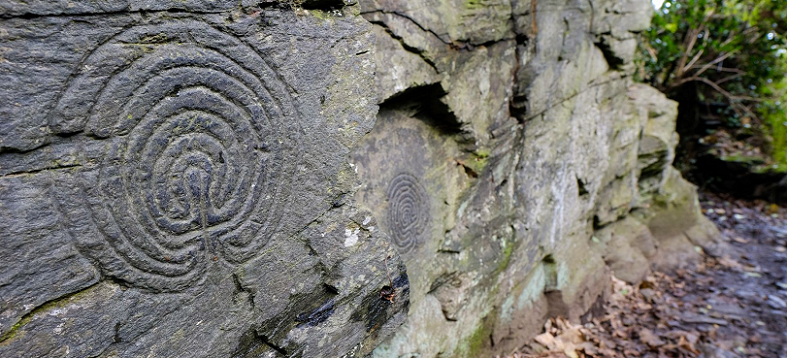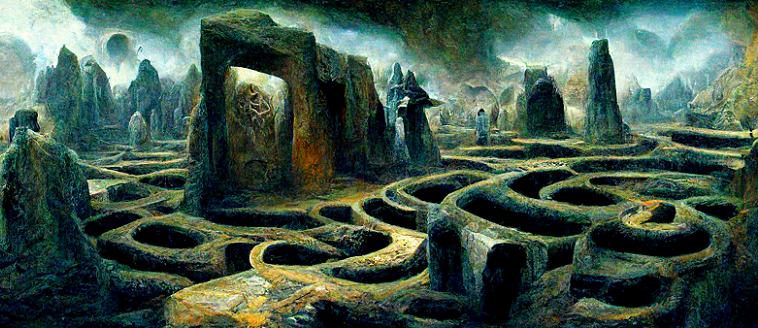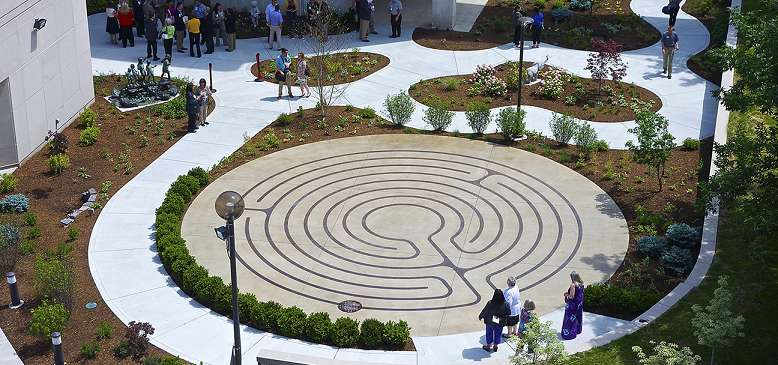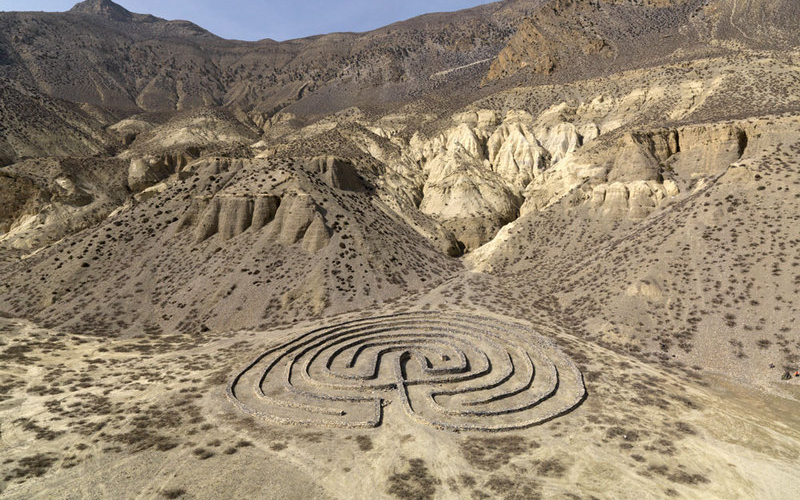Labyrinths have captured the imagination of people for thousands of years, appearing in cultures all around the world. From the Minoan palaces of Crete to the cathedrals of medieval Europe, labyrinths have been used for a variety of purposes, including religious and spiritual rituals, protection, and entertainment.
What Are Labyrinths?
Labyrinths are complex maze-like structures that have been a part of human history for thousands of years. They typically consist of a winding path or series of paths that lead from the entrance to the center, sometimes with twists and turns that make it difficult to find the way.
Labyrinths have been used for a variety of purposes, including religious and spiritual rituals, protection, and entertainment. They have been found in cultures all over the world, from the ancient Minoans in Crete to the cathedrals of medieval Europe.
The symbol and meaning of labyrinths vary widely depending on the culture and era in which they were created, but they often serve as a representation of journey or quest, with the winding path symbolizing the difficulties and challenges that must be overcome in order to reach the goal.
Ancient Labyrinths
Ancient labyrinths have a rich and fascinating history, dating back thousands of years to civilizations such as the Minoans on the island of Crete and the ancient Greeks. The Minoan labyrinths, which were built around 2000 BCE, were complex structures often located within the palaces of the Minoan civilization. These labyrinths were thought to have been used for religious or spiritual purposes, and their design is believed to have influenced the later Greek labyrinths.
The Greek labyrinths, which appeared around the 8th century BCE, were often associated with the myth of the Minotaur, a monster with the body of a man and the head of a bull that was said to live in a labyrinth. These labyrinths were used both as a symbol of the monster and as a representation of the difficulties that the hero Theseus faced in defeating it. The Roman labyrinths, which appeared later, were often used for entertainment and were built as large-scale games that challenged people to find their way through the twists and turns of the maze.

Symbolism Behind Ancient Labyrinths
The symbolism behind ancient labyrinths varies widely depending on the culture and era in which they were created, but they often serve as a representation of journey or quest. The winding path of the labyrinth symbolizes the difficulties and challenges that must be overcome in order to reach the center, with the goal being the ultimate prize.
In ancient cultures such as the Minoans and Greeks, labyrinths were often associated with mythology and religion. In the Minoan culture, labyrinths were believed to have been used for religious or spiritual purposes, with the winding path representing a journey to the underworld or the realm of the gods. In Greek mythology, the labyrinth was associated with the myth of the Minotaur, representing both the monster and the journey of the hero Theseus to defeat it.
In addition to their religious and spiritual significance, ancient labyrinths also served practical purposes, such as protection and defense. The complex design of the labyrinth made it difficult for intruders to find their way to the center, providing a barrier against invaders. In some cultures, labyrinths were even used as a means of trapping evil spirits, keeping them from causing harm to the people who lived nearby.
Mythology and Religion
Mythology and religion have played a significant role in the history of labyrinths, shaping their symbolism and interpretation throughout the centuries. In many ancient cultures, labyrinths were associated with religious beliefs and rituals, serving as a symbol of the journey to the underworld or the realm of the gods.
For example, in ancient Minoan culture, labyrinths were thought to be used for religious or spiritual purposes, representing a journey to the realm of the gods. In Greek mythology, the labyrinth was associated with the myth of the Minotaur, representing the monster and the journey of the hero Theseus to defeat it. The Roman labyrinths, which appeared later, were often used for entertainment and were built as large-scale games that challenged people to find their way through the twists and turns of the maze.
In more recent times, labyrinths have also been associated with Christian symbolism, with the winding path of the labyrinth representing the journey of life and the journey to find God. Many Christian churches and cathedrals have incorporated labyrinths into their designs, using them as a tool for meditation and spiritual reflection.

Protection and Defense
In addition to their religious and spiritual significance, labyrinths have also served practical purposes, including protection and defense. The complex design of the labyrinth, with its twists and turns, made it difficult for intruders to find their way to the center, providing a barrier against invaders.
In ancient times, labyrinths were often used as a form of defense, providing a secure location for storing valuable items or for protecting important people. The intricate design of the labyrinth, with its many twists and turns, made it nearly impossible for intruders to find their way to the center, providing a barrier against theft or attack.
In some cultures, labyrinths were even used as a means of trapping evil spirits, keeping them from causing harm to the people who lived nearby. The labyrinth served as a place of protection and safety, helping to safeguard the community against negative forces and influences.
Today, the idea of the labyrinth as a form of protection and defense continues to inspire people, with labyrinths still being used in a variety of practical applications. From maze gardens to park designs, labyrinths serve as both a decorative element and a place of safety and protection, providing a peaceful and secure environment for people to enjoy.
Cosmic and Spiritual Significance
Labyrinths have a long history of cosmic and spiritual significance, serving as a symbol of the journey of life and the path to the divine. In many cultures, the labyrinth was seen as a representation of the universe, with the winding path symbolizing the journey through life and the challenges that must be faced along the way.
For example, in ancient cultures, the labyrinth was often associated with the journey of the sun and the stars, representing the cyclical nature of the universe and the movement of the celestial bodies. The labyrinth was also seen as a symbol of the journey to the underworld, representing the challenges that must be faced in order to reach the realm of the gods.
In more recent times, labyrinths have been associated with spiritual significance, serving as a tool for meditation and self-discovery. The repetitive motion of walking the labyrinth, with its twists and turns, is thought to quiet the mind and help people to connect with their inner selves, finding a sense of peace and calm.
Labyrinths are also commonly used as a means of exploring the mysteries of the universe, helping people to connect with their own inner wisdom and intuition. The symbolic journey through the labyrinth is seen as a representation of the journey of life, and the challenges that must be faced in order to reach our full potential and connect with the divine.

Modern Interpretations and Uses of Labyrinths
The modern use and interpretation of labyrinths has evolved over the centuries, adapting to the changing needs and beliefs of each era. Today, labyrinths are used for a variety of purposes, including meditation and spiritual practices, garden and park designs, and art and literature.
One of the most popular modern uses of labyrinths is for meditation and spiritual practices. People walk the winding path of the labyrinth as a form of meditation, using the repetitive motion to quiet their mind and focus on the present moment. Labyrinths are often used as a tool for spiritual growth and self-discovery, helping people to connect with their inner selves and find a sense of peace and calm.
In addition to their use for meditation, labyrinths are also commonly incorporated into garden and park designs, serving as both a decorative element and a place for recreation and relaxation. Many public parks and private gardens feature labyrinths, allowing people to walk the path and enjoy the peaceful surroundings.
Finally, labyrinths have also played a role in art and literature, inspiring artists, writers, and filmmakers to create works that incorporate the symbolism and mystery of the labyrinth. Whether used as a metaphor for the journey of life or as a representation of the challenges that must be overcome, labyrinths continue to captivate the imagination and inspire new interpretations and uses.
The modern interpretations and uses of labyrinths reflect the enduring legacy of this ancient symbol, adapting to the changing needs and beliefs of each era while retaining its power to inspire and transform.

